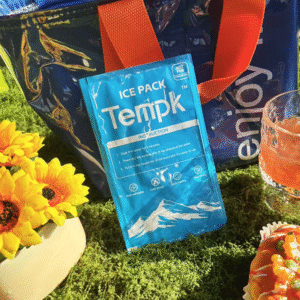Paquetes de hielo seco del Reino Unido: Cómo enviar productos congelados de forma segura?
You want frozen products to arrive rock‑solid without expensive over‑packing. UK dry ice packs keep goods below –18 °C for long lanes when gel or standard PCM can’t cope. In this 2025 guía, you’ll get right‑sizing rules, IATA/ADR labeling, carrier do’s and don’ts, and field‑tested pack‑outs that lower cost and risk on UK routes.
-
Como UK dry ice packs work and when are they the right choice for frozen shipping in the UK?
-
How many kilograms of dry ice hold for 24–96 hours on typical UK lanes and seasons?
-
How to pack and label UK dry ice packs to meet IATA PI 954 and ADR requirements?
-
Should you choose UK dry ice packs or –21 °C PCM or gel packs for different payloads?
-
Qué 2025 trends affect sourcing, seguridad, and sustainability of UK dry ice packs?
What are UK dry ice packs and when should you use them?
El hielo seco es dióxido de carbono sólido (Y 1845), clase 9, at –78.5 °C; it cools as it sublimates to gas. That ultra‑low temperature gives UK dry ice packs unmatched “cold headroom” for ice cream, biológicos, and specialty foods over 48–96‑hour lanes or during heat spikes. It’s ideal when you must maintain deep‑frozen stability or recover quickly from depot dwell.
Por que importa: Each kilogram of dry ice absorbs substantial heat as it turns to CO₂ gas, so small masses deliver big protection. Because CO₂ gas is heavier than air, you must vent packages and storage areas to avoid oxygen displacement risks.
How do UK dry ice packs differ from gel or –21 °C PCM?
“Extra cold” in practice means deeper temperature capability and higher cooling capacity. Gel holds around 0 °C and suits chilled. –21 °C PCM stabilizes frozen but struggles with long hot dwell. UK dry ice packs run at –78.5 °C, offering faster pull‑down and better recovery from short heat spikes, if you respect venting and labeling rules.
| Cooling Source | Typical Temp Band | What to expect | Lo que significa para ti |
|---|---|---|---|
| UK dry ice packs (Y 1845) | –78,5°C | Deep‑freeze control; gas needs venting | Best for frozen, 48–96h; label Class 9 |
| –21 °C PCM | ~–21 °C plateau | Stable but less “recovery power” | Good for stable 24–72 h lanes |
| paquetes de gel | 0 °C to –5 °C | Chilled only | Not for deep‑frozen payloads |
Consejos prácticos que puede usar hoy
-
Top‑load placement: Poner UK dry ice packs por encima de la carga útil; CO₂ gas sinks and bathes goods in cold air.
-
Create gas paths: Never seal gas‑tight; a small vent or “breathing” lid prevents pressure build‑up.
-
Protect people: Utilice guantes aislantes y protección para los ojos.; avoid confined, unventilated rooms.
Ejemplo del mundo real: A UK dessert brand moved to top‑loaded UK dry ice packs with a vented lid and reduced summer failures from 6.5% to under 1% while trimming coolant by ~15% after logger validation.
How to size UK dry ice packs for 24–96 hours?
Start with heat load, then convert to kilograms of dry ice. A field rule for mid‑size EPS (12–24 L) is 2–3 kg for ~24 h, 4–6 kg for ~48 h, and 6–9 kg for ~72 h—always validate with loggers and your lane profile. Mejor aislamiento (2″EPS o VIP) cuts mass substantially. The goal is right‑sizing, not oversizing.
A simple 5‑step sizing method (you can copy)
-
Estimate heat leak (Q̇): U‑value × surface area × ΔT.
-
Multiply by time: Q=Q˙×tQ = Q̇ \times t (KJ).
-
Add product pull‑down: If starting above target.
-
Add 20–30% safety margin: For depot dwell or weekend hold.
-
Divide by 571 kJ/kg: First‑pass kilograms of UK dry ice packs.
| Lane Duration | EPS 1.5″ wall | EPS 2.0″ wall | Cargador VIP | Lo que significa |
|---|---|---|---|---|
| 24 H | 2–3kg | 1.5–2.5 kg | 1–2 kg | Start lean; validate with two loggers |
| 48 H | 4–6 kg | 3–5 kg | 2–4 kg | Add buffer in summer |
| 72 H | 6–9 kg | 5–7 kg | 3–6 kg | Consider side runners |
| 96 H | 8–12 kg | 7–10 kg | 5–8 kg | Move to VIP + PCM híbrido |
“UK dry ice packs” quick‑calc you can adapt
Para la punta: Logger curves reveal when dry ice is gone—the temperature slope steepens. If that happens long before delivery, increase mass or upgrade insulation, not both.
How to pack and label UK dry ice packs to comply?
Follow IATA Packing Instruction 954 (aire) and ADR (camino), mark UN 1845 “Carbon dioxide, sólido (hielo seco)", and display net dry ice mass in kg with a Class 9 label. Packages must allow CO₂ to escape to prevent pressure build‑up; Nunca use contenedores herméticos.
Document updates for 2025: The IATA DGR 66th Edition addendum (April 30, 2025) re‑emphasizes aircraft‑type limits for UN 1845 and the requirement to indicate the net dry ice weight. Keep your ops manual aligned with the current addendum and carrier variations.
UK carrier reality check (parcel networks)
-
Royal Mail/Post Office: Consumer parcels cannot use dry ice for food; the guidance explicitly says “Don’t use dry ice or frozen water.” Businesses should also verify restricted goods lists before attempting DG shipments.
-
Express integrators (FedEx/UPS): Dry ice is accepted as dangerous goods with PI 954 rules; contracts or DG approvals may be required.
-
DPD/road networks: Policies vary by country and service; dry ice as a coolant is possible under DG frameworks, but check operator guidance and ADR obligations.
-
Government overview: If you transport dangerous goods by road, follow official packing and labeling rules and ensure driver/company compliance.
Important nuance: A shipper’s declaration is generally not required for packages containing only UN 1845 used as a refrigerant for non‑dangerous goods, but you must still apply PI 954 markings/labels and net mass. Confirm carrier‑specific variations.
Vented packaging and labeling for UK dry ice packs
Haz esto cada vez:
-
Use packaging designed to vent CO₂ gas.
-
Mark “UN 1845”, "Hielo seco" o "dióxido de carbono, sólido", y el Kg neto de hielo seco.
-
Affix the Class 9 hazard label in the correct format and position.
| Requisito | Por que importa | como hacerlo | Para ti |
|---|---|---|---|
| Desfogue | Previene la construcción de presión | “Breathing” lid or vent holes | Seguridad & cumplimiento |
| Y 1845 + Kg neto | Aceptación del transportista | Print net mass legibly in kg | Faster induction |
| Etiqueta de clase9 | DG identification | Use correct size & orientation | Avoid refusals |
UK dry ice packs vs –21 °C PCM vs gel: which wins your lane?
Match cold source to your temperature target and lane volatility. For deep‑frozen products and unpredictable dwell, UK dry ice packs deliver the best protection. For stable 24–48 h frozen lanes, –21 °C PCM can work and simplifies handling. Gel is ideal for chilled (0–5 ° C) and not for deep freeze.
Total cost and risk trade‑offs
-
UK dry ice packs: Highest “cold headroom,” needs PPE, desfogue, etiquetado; economical for high‑value frozen goods.
-
–21 °C PCM: Great for stability and reusability; add a small top‑load of dry ice for summer heat spikes.
-
Gel: Cheapest pack‑out, but only for chilled.
| Opción | Materials cost | Manejo | El mejor uso | Lo que significa |
|---|---|---|---|---|
| UK dry ice packs | Medio | DG labeling & PPE | Congelado, 48–96h | Lowest spoilage risk |
| –21 °C PCM | Medium‑High | Simple | Congelado, 24–72h | Temperaturas estables |
| paquetes de gel | Bajo | Simple | Enfriado, 12–48h | Not deep‑freeze |
Safety basics for UK dry ice packs (people and places)
Risks: Asphyxiation in poorly ventilated spaces, cold burns/frostbite, pressure build‑up in sealed containers. UK health and safety bodies and UK suppliers emphasize ventilation, PPE, and training as the core controls.
Practical controls:
-
Work in well‑ventilated rooms; monitor CO₂ where necessary.
-
Use guantes aislados y protección para los ojos; use tongs or scoops.
-
Almacenar UK dry ice packs in insulated, non‑airtight containers; never in sealed car boots.
-
Capacitar al personal; keep SOPs simple and visual.
Note for air passengers (no carga): UK CAA guidance limits personal baggage to ≤2.5 kg of dry ice per person when used to pack perishables, subject to airline approval. This is separate from cargo rules under PI 954.
Building a compliant pack‑out with UK dry ice packs
Use a top‑load, side‑runner design with a corrugate barrier and vent path. This pattern improves cold wash over the payload and reduces shifting.
Paquete paso a paso (repeatable SOP)
-
PPE & staging: Guantes, gafas de protección, tenazas, kraft wrap.
-
Box prep: Insert liner, tape seams, leave a vent gap.
-
Load product: Pre‑frozen items in a snug inner carton.
-
Add coolant: Carga superior UK dry ice packs; add side runners if space allows.
-
Relleno de vacío: Papel kraft; avoid blocking vents.
-
Sello & etiqueta: Tapa ventilada; apply UN 1845, Kg neto, and Class 9; add orientation arrows.
-
Handoff: Record net kg and box ID in WMS for traceability.
Pack‑out QA signals to watch
| Logger signal | What you see | Causa probable | que cambiar |
|---|---|---|---|
| Early plateau end | Temp rises after 12–18 h | Too little dry ice | Add 20–30% mass |
| Saw‑tooth swings | ±5–10 °C oscillation | Loose pack‑out | Llenar los vacíos; add side runners |
| Gradual warm trend | ~0.5–1 °C/h rise | Insulation leak | Upgrade to 2″ EPS or VIP |
Sustainability and cost: can UK dry ice packs be greener?
Yes—right‑size the mass, upgrade insulation, and reduce failures. VIP or thicker EPS cuts required kilograms, lowering emissions from production and sublimation. Pair –21 °C PCM on the sides with a small top‑load of UK dry ice packs for recovery, not base load.
Disposal and storage: Ventilate rooms and vehicles; never dispose of dry ice in sinks or sealed bins. UK safety guidance highlights CO₂ displacement hazards and recommends well‑ventilated areas for use and disposal.
Three fast wins
-
Improve R‑value before adding mass: Insulation upgrades often save 20–40% dry ice.
-
Lane‑specific standards: Different UK lanes need different net kg; avoid one‑size‑fits‑all.
-
Post‑delivery guidance: A one‑page insert for recipients reduces incidents and support calls.
2025 trends in UK dry ice packs and frozen logistics
Regulatory clarity and data‑driven right‑sizing are the big shifts in 2025. The IATA DGR 66th Edition addendum (April 2025) underscores aircraft‑type limits and net‑mass indications for UN 1845, while carriers refresh acceptance checklists. UK frozen retail remains resilient, with trade press and market trackers reporting ongoing value growth and category innovation.
Últimos desarrollos de un vistazo
-
Updated acceptance checklists: Standardized PI 954 checks reduce induction errors and rejections.
-
Carrier policy transparency: FedEx/UPS UK refresh “how to ship dry ice” pages; contracts may be required.
-
Category momentum: UK frozen continues to attract shoppers seeking value and convenience, supporting more small‑batch frozen D2C offers.
Insight del mercado: Despite price pressures, frozen convenience stays attractive in UK baskets, keeping demand steady for UK dry ice packs to protect high‑value frozen goods in e‑commerce and B2B lanes.
Image references (illustrative)
Interactive checklist: are your UK dry ice packs ready?
Score 0–2 for each item (0 = no, 1 = partly, 2 = yes). Add your points.
-
Lane profile validated with loggers in the past 90 días
-
Insulation verified (≥2″ EPS or VIP for ≥72 h lanes)
-
UK dry ice packs top‑loaded with side runners and barrier sheet
-
Tapa ventilada; Etiqueta de clase9; Y 1845 + net kg marked
-
SOP card for receivers; PPE available at pack‑out
Resultados:
-
8–10 points: Good to ship frozen confidently.
-
5–7 points: Adjust mass or insulation and re‑test.
-
0–4 points: Pilot two pack‑outs before going live.
UK dry ice packs: Preguntas frecuentes
Can I send food with UK dry ice packs via Royal Mail?
No. Royal Mail guidance for sending food says don’t use dry ice or frozen water in parcels. Use DG‑capable couriers instead.
What must appear on the label for UK dry ice packs by air?
Display “UN 1845”, the words “Dry Ice” or “Carbon dioxide, sólido", el peso neto en kg, y un Clase9 etiqueta de peligro; the packaging must vent gas.
Do I need a shipper’s declaration if I only use UK dry ice packs?
Generally no—when dry ice cools non‑dangerous goods, a declaration isn’t required, but PI 954 markings still apply and operator variations may exist.
Are there special contracts for integrators?
Sí. UPS notes that dry‑ice shipments may require an ISC or DG contract; FedEx UK provides dry‑ice instructions and training requirements.
What about road transport requirements in the UK?
ADR applies to dangerous goods by road; asegurar el embalaje adecuado, calificación, and driver/company compliance.
Es seguro de hielo seco para manejar?
With ventilation, guantes, and eye protection, Sí. Risks include asphyxiation and cold burns; follow UK safety guidance.
Resumen & next steps for UK dry ice packs
Control de llave: UK dry ice packs deliver the deepest freeze margin for UK lanes, but compliance matters. Right‑size by calculating heat load, then validate with loggers. Pack top‑load with vent paths, mark UN 1845 with net kg, and apply Class 9. For stability and sustainability, combine VIP or –21 °C PCM with a smaller dry‑ice top‑load.
Plan de acción: Pilot two pack‑outs with different UK dry ice packs masses and log both; upgrade insulation before adding kilograms; publish a one‑page SOP; confirm 2025 PI 954/ADR requirements with your carriers; review results in 30 days and lock lane standards.
Acerca de Tempk
We are a UK‑focused cold chain team delivering validated pack‑outs, compliant labeling, and lane‑specific sizing for UK dry ice packs. Our solutions include VIP/EPS shippers, –21 °C PCM, Plantillas SOP, and training that reduce failures and total cost. We pair field testing with simple tools so your shipments arrive frozen—and stay that way.
CTA: Request a free frozen‑lane audit and get a tailored UK dry ice packs sizing sheet for your network.
























